1. Introduction
1.1. Research Background
Due to the rise of modern science and technology, there are more different ways of shopping on the market. E-commerce is booming and a whole new shopping mode is opened on the market. From the most traditional offline shopping (department stores) to online shopping and a variety of platforms, efficient shopping methods are gaining popularity around the world. Since the 1990s, with the breakthrough of network, communication and information technology, Internet has experienced explosive growth and rapid popularity in the world. E-commerce is a brand new business model based on the Internet, taking both sides of the transaction as the theme, taking electronic payment and settlement of banks as the means, and relying on customer data. It can make businesses and consumers more closely linked, more quickly, systematic understanding and meet consumer needs. It also gives businesses the opportunity to sell their products in a global market.
A study released by Shanghai Eastday Data Technology Co. LTD shows that China's e-commerce industry has grown rapidly in recent years, with more than 100,000 online stores and about 100,000 items displayed online. According to relevant data, China's online auction market reached nearly 940 million yuan in 2002, and 1.92 billion yuan in 2003 [1]. This shows that China's future e-commerce industry development has considerable potential. This study investigates the differences between traditional shopping and modern shopping and analyzes the advantages and disadvantages of them. This can help merchants better improve their online consumption platform and applicate the store management elements (distribution, display, price, inventory, sales support, promotion). At the same time, it can also help merchants find strategies to promote consumers' consumption and demand, or extract important information from them to predict the development trend and sustainability of modern shopping methods in the future.
1.2. Literature Review
1.2.1. Offline Shopping
In the 1980s, the economy began to recover, people's living standards gradually improved, and large department stores sprang up. People use the holiday time spend time with their friends or alone to go shopping, buy clothes and other daily necessities. Liang proposed that this most traditional way of shopping has certain advantages: what consumers can get is not only the commodity, but also the pleasure of the whole shopping process, the pleasure of being in it, participating in it and enjoying it: they can bargain with the salesman and finally buy the satisfactory commodity at the lowest price [2]. Since the new way of shopping can appear, it means that the traditional way of shopping has some drawbacks.
1) In a offline store, no matter how big the space is, the goods it can accommodate are very limited;
2) In offline stores, the information of goods is updated slowly, and the buyer can only see the new goods after the store puts them on the shelf.
3) In offline stores, buyers need to spend more time and energy looking for goods.
4) In offline stores, consumers are mostly limited by business hours. Some people's working hours just conflict with the business hours of the mall, can not buy their own needs of daily necessities on time;
1.2.2. Online Shopping
With the change of information communication technology and the rise of media. From traditional offline shopping to online shopping on software. Users can acquire knowledge while consuming. More new consumption platforms have changed the consumption habits of many consumers. A short video software called TikTok, short videos within the software are driving the potential consumption of users. Zhang found that in this era of fast pace of life, the commonly accepted information is fragmented. This is in line with the development of short video. For example, when taking the subway or bus, they would choose to kill time by watching short videos and live streaming. Therefore, anchors on TikTok platform generally bring their own products, and the information consumer obtain is of practical reference value [3].
The vivid forms of short videos and live broadcasts on TikTok enable multi-dimensional product information to be clearly presented. Users can not only see and hear the advantages of the product, but also feel the real usage scenes, which greatly stimulates users' interest in the product and purchase behavior. When users come to the e-commerce platform of TikTok. Not only with the need for content consumption. But also with a lot of potential shopping interest. The platform provides content and goods to merchants together, arouses users' interest in shopping, and at the same time, drives the business growth of merchants and brings greater development space for merchants.
Zhang mentioned that when using this new software, the mobile phone will be pushed too much spam information, which will bring a lot of unnecessary trouble to users [3]. At the same time, when too much attention is paid to the audio-visual effect while ignoring the content and connotation construction, or the theme is too repetitive. Thus, they will be losing the creativity and the meaning of the video content. If the products sold by merchants are inconsistent with the actual effect, they will attract complaints and negative comments from consumers, which will have a certain negative impact on the brand image. Meanwhile, the sellers will be unable to make profits due to the negative feedback from buyers. Liang also stated that the characteristics of online and offline communication networks have a significant impact on the process and results of consumers' consultation on online shopping information [4].
Web page is the first link to carry out and complete online shopping, and consumers' subsequent product search, product selection, customer communication, payment process, after-sales feedback and a series of purchase behaviors will be built on this basis [5]. Traditional offline physical stores will attract consumers through exquisite store decoration, as well as highly artistic product matching, and the same, the overall tone of the e-commerce web page, picture size, page layout and a series of overall design style will also have an impact on consumers' first emotional impression and whether it will continue to produce purchasing behavior.
1.3. Research Gap
First of all, most authors of this paper have studied the experience of consumers in different ways of shopping, as well as the general situation and characteristics of consumption in different scenarios. In addition, for those scholars who analyze social media marketing, many of them will choose specific brands or software as objects for analysis. In the face of more detailed analysis, the disadvantages and advantages of brands and software will be amplified.
On the contrary, few scholars mention the future development of traditional and modern ways of shopping. They only give summaries and statement of views in the face of the current situation. Fewer scholars present both the problem and the solution.
1.4. Research Framework
First of all, this paper describes the background of the rise of e-commerce, the rise of many different shopping methods for people to choose in the market. Second, because of the rise of e-commerce, online shopping as a mainstream network service has more potential development. As a result, the relationship between business and customer becomes closer, people can enjoy the convenience of high technology, and businesses can enjoy the profits of bringing their goods to the global market. Lastly, this paper summed up the advantages and disadvantages of two different shopping methods respectively.
2. Research Method
2.1. Comparative Analysis
Comparative analysis is a way to look at two or more similar things to see how they are different and what they have in common. It is used in many ways and fields to help people understand the similarities and differences between products better. It can help businesses make good decisions about key issues [4]. This paper makes a comparative analysis between the traditional way of shopping (offline) and the modern way of shopping (online), and explains the characteristics of the two ways of shopping simply. At present, this paper further analyzes how the modern way solves the problem of the traditional way of shopping to a better level (invented more convenient and advanced shopping methods).
2.2. Literature Review
A literature review summarizes research on a topic made from previous academic articles, books, and other literature sources. The literature review will include a listing, description, summary, objective evaluation, and clarification [5]. This paper adopts the method of literature review and draws on the characteristics, advantages and disadvantages of the two shopping methods summarized by other authors. This paper also integrates short video software related literature to understand the form and characteristics of marketing behind short video. Combined with all the important information, to further understand how business use the software function to achieve product sales.
2.3. Questionnaire
Combined A questionnaire is a research instrument that consists of a set of questions (or other types of prompts) for the purpose of gathering information from respondents through survey or statistical study [6]. This survey designed six questions related to this research, aiming to investigate the frequency of users using online shopping platforms, users' consumption preferences, consideration factors, shortcomings and advantages of online shopping platforms. This enables more accurate and real data to be obtained in this paper. Help surveyors better locate future consumption trends.
3. Result
3.1. Questionnaire Result
Q1. What factors influence your personal consumption expenditure
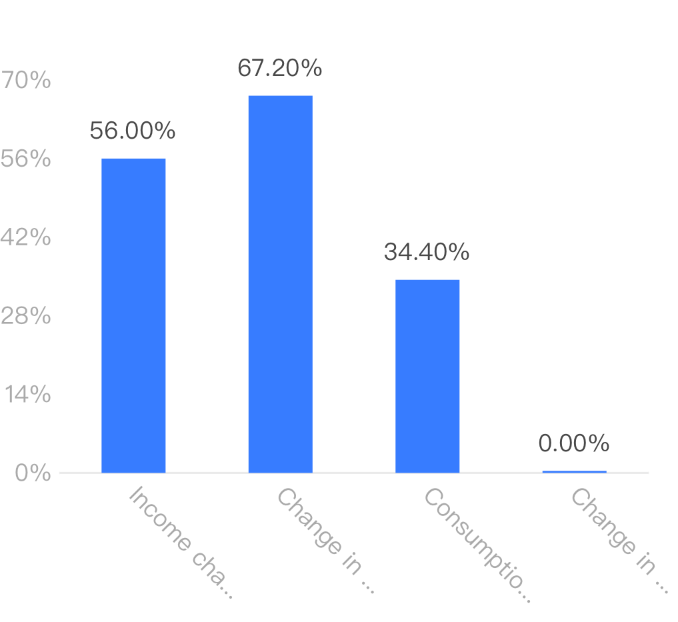
Figure 1: The result of 1st question.
Options | Selection frequency | Percentage |
Income change | 70 | 56.00% |
Change in consumption demand | 84 | 67.20% |
Consumption environment and situation change | 43 | 34.40% |
Change in fixed payment costs | 0 | 0.00% |
Respondents 125 | ||
Q2. Which online consumption channels do you usually use
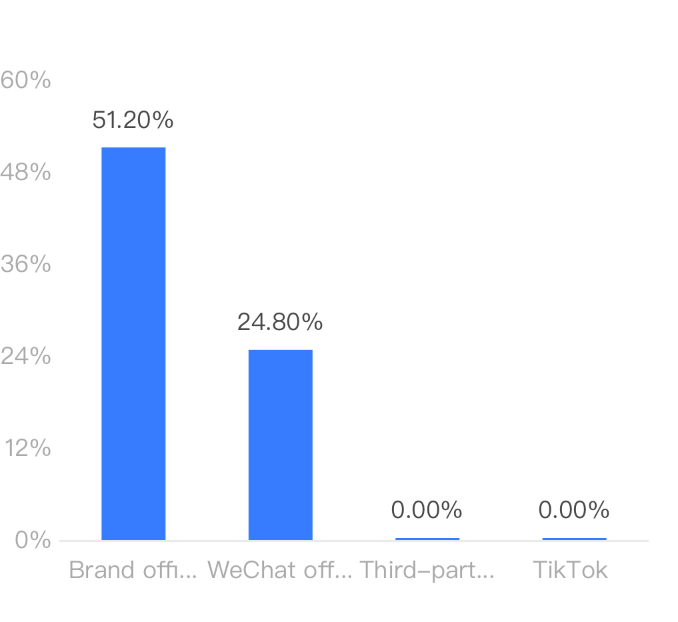
Figure 2: The result of 2nd question.
Options | Selection frequency | Percentage |
Brand official website, APP | 64 | 51.20% |
WeChat official online store, WeChat mini program | 31 | 24.80% |
Third-party platform (Taobao, Jingdong) | 0 | 0.00% |
TikTok | 0 | 0.00% |
Respondents 125 | ||
Q3. What do you think is the biggest advantages of online shopping?
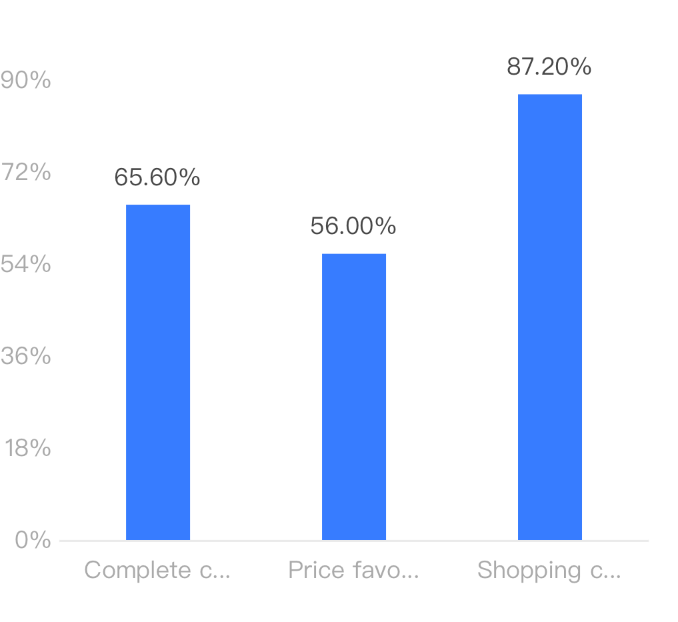
Figure 3: The result of 3rd question.
Options | Selection frequency | Percentage |
Complete category | 82 | 65.60% |
Price favorable | 70 | 56.00% |
Shopping convenience | 109 | 87.20% |
Respondents 125 | ||
Q4. What do you think is the biggest disadvantage of online shopping
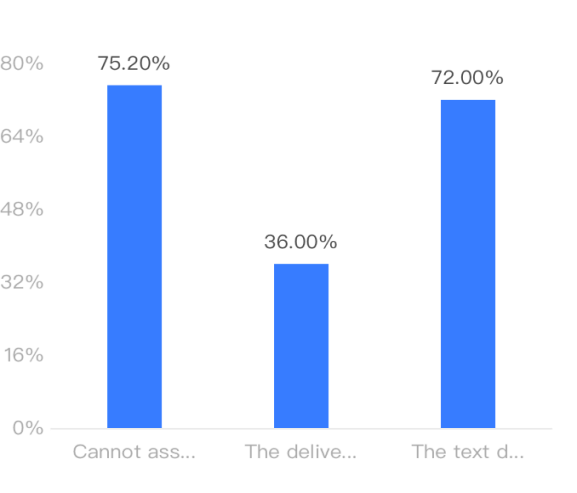
Figure 4: The result of 4thquestion.
Options | Selection frequency | Percentage |
Cannot assure quality | 94 | 75.20% |
The delivery time is too long | 45 | 36.00% |
The text does not match the real thing | 90 | 72.00% |
Respondents 125 | ||
Q5. What do you consider first when you consume
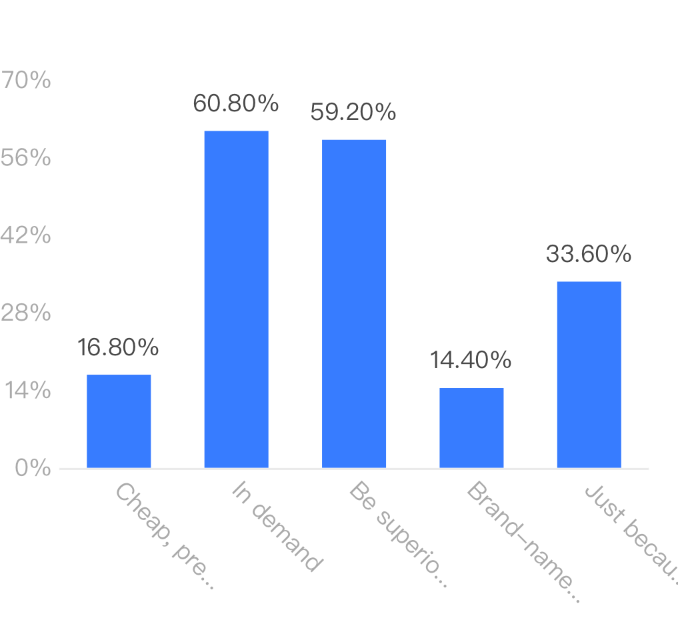
Figure 5: The result of 5thquestion.
Options | Selection frequency | Percentage |
Cheap, prefrential | 21 | 16.80% |
In demand | 76 | 60.80% |
Be superior in quality | 74 | 59.20% |
Brand-name products | 18 | 14.40% |
Just because like | 42 | 33.60% |
Respondents 125 | ||
Q6. What kind of shopping do you think will take a larger proportion of your future consumption
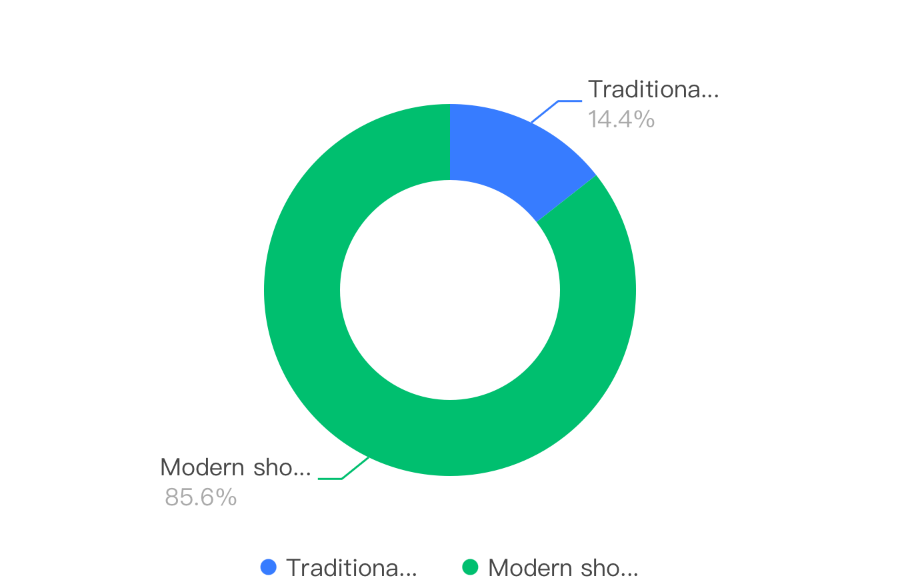
Figure 6: The result of 6thquestion.
Options | Selection frequency | Percentage |
Traditional shopping way (offline) | 18 | 14.40% |
Modern shopping way (online) | 107 | 85.60% |
Respondents 125 | ||
Before listing the advantages and disadvantages of online shopping, the answers of the questionnaire are better be listed, so as to facilitate a more detailed analysis and explanation of these advantages and disadvantages.
Firstly, the first question is whether consumers prefer online consumption or offline consumption in their consumption habits. The results show that 68.6% of consumers prefer online shopping platforms. The first question can be linked to the last one, where more consumers believe that online shopping will account for a higher share of their future total consumption (85.6%).
The second question asks about online shopping software commonly used by consumers, such as brand official website and software, WeChat online mall and WeChat mini program, third-party platform and TikTok. The results showed that more people used the first two items for online shopping. This proves that third-party platforms need to work harder to improve the shortcomings of their shopping platforms so that more people can consume on their platforms.
The third question asks consumers what they think are the biggest advantages of online spending. Consumers think that the biggest advantage of online consumption is convenience, and then online platforms have more kinds of choices, also online shopping stations offer more discounts. These are the most attractive factors for online platforms. Therefore, in the future, various industries can strengthen in these aspects, so as to make their brands more popular in online shopping market.
The fourth question, in contrast to the third, asked consumers to choose what they thought were the most serious drawbacks of online shopping. The feedback is that consumers believe that the most common problems in online shopping are the inconsistency between the pictures and the real goods and the inability to guarantee the quality of the goods. A relatively small part of the answer was the long delivery times. It can be seen that these are the most common problems in online shopping, and these problems must be minimized before online shopping is fully popularized.
The fifth question, ask consumers what factors they typically consider when making purchases. Most consumers are attracted to the product because they have the demand and the quality of the product. And then, because they like the product. Lastly, because the product is well-known and affordable. Therefore, businesses need to make their products look creative and attractive while ensuring its quality.
3.2. Analysis of Online Shopping and Offline Shopping
3.2.1. Advantages of Online Shopping
For consumer:
1) The cost advantage of online shopping: After a long-term comparison, people find a major advantage of online shopping is: The cost of online sales is lower than the cost of physical sales. Because online goods save a series of expenses such as renting stores, hiring employees and storage, their prices are generally cheaper than similar goods in general shopping malls, which saves consumers a lot of expenses, which is a big reason why many people choose online shopping.
2) The convenience of online shopping: The customer does not need to spend hours or more in various malls and shopping centers to search for the goods he needs, he just needs to sit in front of the computer, type in the search engine "online store", hundreds of search results will be displayed in front of him; After purchasing the desired goods, customers just sit at home waiting for the goods to be delivered. At the same time, customers do not need to shop within the specified time, Customer can carry out the selection of goods and shopping in any time, payment methods are diverse too, online shopping can realize online payment, mobile phone payment, bank remittance payment, etc., so as to save a lot of time and energy [6].
3) Another very important feature of online shopping is that it has a wide variety of commodities. Many commodities that are not available in the market can only be bought online, which greatly enhances people's dependence on online shopping.
4) Consumer review: This is also one of the advantages of online shopping, which can help potential users get reliable information from buyers before buying products. Once a user buys a product on a third-party platform, the online shopping platform will advise consumers to upload their experience of the product to the corresponding platform, so that other customers can read the information and make their own decisions about whether to buy it. All these can reduce the fault tolerance rate of consumers when choosing products.
For merchant:
Because online sales without inventory pressure, low operating costs, operating scale is not limited by the site. In the future, more enterprises will choose online sales and adjust their business strategies through the timely feedback of market information on the Internet, so as to improve the economic benefits of enterprises and the ability to participate in international competition.
3.2.2. Disadvantages of Online Shopping
Even though the online shopping mode is much more convenient than the traditional offline consumption mode, the online shopping system still has relatively serious problems.
1) Logistics problems: The logistics of online shopping is very limited. To be specific, some remote areas cannot be delivered. Some express companies have slow logistics speed but high prices and poor service quality. For example, a woman bought a new mobile phone case from the Internet, but she still did not receive the product half a month later. After several negotiations with the customer service staff of the shopping website, she realized that her home was in remote area and thus delayed the delivery of the product. Finally, the shop agreed to refund half of the payment, which is equivalent to the woman spent half price on the air. Such things often happen in daily life. This problem both affects usage and wastes time.
2) Fraudulent act (poor product quality): There are sites where the actual product is different from the picture displayed, usually beautifying the product so as to achieve the perfect visual effect for people; What is more, the merchant deliberately simplifies the information of the product, making the information incomplete, so that the buyer cannot really understand the product.
3) Return of products: This is a common problem faced by online shopping companies. While in offline stores, customers can go to the corresponding store to change their goods if they are not satisfied, in the case of online shopping, consumers need to call customer service and wait for the Courier to reverse logistics, get the money back or replace the products. Sometimes the whole process can take a full month, thus the time cost of return process is extremely high. Although most online shopping sites offer money-back guarantees or product replacement services, this can make the shopping experience much less rewarding [7].
3.2.3. Advantages of Offline Shopping
1) Tangibility and testability: In a physical store, customers can touch the product, feel the product, and get a first-hand demonstration. If it is clothing, before buying customer can also try it on, which avoids a lot of misunderstanding and unnecessary conflicts between merchant and consumers. However, in online shopping platforms, merchants can only provide consumers with pictures and specifications of products, which in some cases may not be enough to make informed purchases [8].
2) Shopping experience: Shopping is more than just going through the motions and buying things. Shopping itself is a very enjoyable process, where consumers can sift the products and feel the colors and textures of products. On the contrary, online shopping cannot meet the above conditions, so the pleasure of online shopping is far less than that of offline shopping.
4. Discussion
4.1. Solutions for Online Shopping Platforms
4.1.1. Combination of Online and Offline Services
With an in-store combination of online and offline services, retailers are providing customers and employees with access to tools online using various technology platforms. For example, Prada, allows customers to collect the clothes they've tried on on their mobile phones, create their own web pages, and then email them to friends to ask for their opinions. A number of retailers, from Borders to REI, the outdoor specialists, have introduced Internet kiosks to their retail space with varying degrees of success [9].
4.1.2. Intelligent Recommendation Offline Stores
Moreover, if consumers want to go to offline stores for consumption, the online shopping platform can intelligently recommend the nearest stores for them, with detailed address and navigation, so as to facilitate consumers shopping in the offline stores.
4.1.3. Encourage Consumers to Post Consumer Review
After the customer has confirmed receipt, remind them that they can receive a series of rewards if they post a consumer review. Store coupons, vouchers, giveaways, etc. In this way, some consumers can be attracted to publish consumer review on their own initiative. Therefore, more consumers can see the real comments from users and avoid many goods that should not be consumed. For shops with high credit it is undoubtedly a good opportunity for them to increase their reputation, attract more loyal consumers.
4.1.4. Membership System
Membership system have a significant impact on both online and offline stores. Membership system have high retention rate, high frequency of purchase, members can also help merchants to carry out propaganda with zero cost. More than 50% of new customers are referred by members. For customers in stores, merchants can encourage customers to apply for membership cards, so that online shopping can be realized by virtue of membership status. In contrast, stored value cards seem to be more attractive, which can increase repurchase of goods.
4.2. Suggestion for Consumers
4.2.1. Choose Websites With Good Reputation
Good credit service website, usually have a good reputation. Before buying items, you can browse the forum to listen to the evaluation of the Internet users, as far as possible to fully understand the strength and credibility of the site and the owner of the past.
4.2.2. Learn to Use the Search Function When Shopping
When consumers find what they want, don’t hurry to place an order. Leave a message to the merchants and communicate to the owner to determine the postage and the necessary details of the goods to be consume. On the one hand, communication with merchants is the best way for consumers to know to what they really need; Moreover, if consumers are good on communicate, some shop owners will give them a better discount.
5. Conclusion
5.1. Findings
This paper studies online shopping and offline shopping respectively, and analyzes consumers' consumption awareness and motivation, as well as the development trend of the two shopping methods under these two different consumption environments.
Online shopping is a form of electronic commerce which allows consumers to directly buy goods or services from a seller over the Internet using a web browser or a mobile app [10]. And Offline shopping is a traditional way of purchasing services or products by directly visiting to the shop [11].
In addition, this paper compares the two shopping methods, summarizes the characteristics, advantages and disadvantages of online shopping and offline shopping by means of questionnaires and literature review. Finally, effective solutions and suggestions are obtained by referring to the information from website.
This paper help businesses to think from the perspective of consumers and help them better understand consumers' consumption motivation. This gives enterprises and businesses better development opportunities and effective suggestions
5.2. Limitation
However, this paper also has some limitations. This paper analyzes only a few forms of the two shopping ways, not all of them are fully analyzed. In addition, only secondary data are applied for the potential problem analysis and suggestion. These secondary data may be outdated, and the solutions mentioned in this paper may not keep up with the rapid change in marketing in the following years. Also, the number of respondents to the questionnaire did not reach a very significant number, so the data are lack of representativeness. In future research, large-scale experiments can be designed to improve the representativeness and accuracy of data. At the same time, the analysis should refer to secondary data that is close to the current situation.
References
[1]. Chen Yiwen, Ma Jiwei. Consumer purchasing decisions and its influencing factors in e-commerce [J]. Progress in psychological science, 2012, 20 (1): 8. DOI: CNKI: SUN: XLXD. 0.2012-01-006.
[2]. Liao Jianhui. Business model Subversion: A Comparative analysis of Online shopping and traditional shopping model [J]. [2023-06-16].
[3]. Jinghan Zhang,Z. (2021) Proceedings of the 6th International Conference on Economics, Management, Law and Education (EMLE 2020). Analysis on the Commercialization Phenomenon of Short Video Platform Douyin in China.
[4]. Liang Zhikang, Wu Jun. Research on the impact of Online and Offline communication Network on consumers' First purchase intention in the context of online shopping [J]. 2014.
[5]. https://www.thoughtco.com/literature-review-research-1691252
[6]. https://www.questionpro.com/blog/comparative-analysis/
[7]. Gupta Puja,P. (2015) Comparative Study of Online and Offline Shopping: A Case Study of Rourkela in Odisha. MA thesis:1
[8]. https://en.wikipedia.org/wiki/Online_shopping
[9]. Chen Yiwen, Ma Jiwei. Consumer purchasing decisions and its influencing factors in e-commerce [J]. Progress in psychological science, 2012, 20 (1): 8. DOI: CNKI: SUN: XLXD. 0.2012-01-006.
[10]. Jasmandeep Kaur,L., Surabhi Singh,S., Ramanjeet Singh,S. (2022) AI and Customer Experience in the Fashion Industry. Adoption and Implementation of AI in Customer Relationship Management:12
Cite this article
Wang,K. (2023). Analysis of Online Shopping and Offline Shopping. Advances in Economics, Management and Political Sciences,37,8-18.
Data availability
The datasets used and/or analyzed during the current study will be available from the authors upon reasonable request.
Disclaimer/Publisher's Note
The statements, opinions and data contained in all publications are solely those of the individual author(s) and contributor(s) and not of EWA Publishing and/or the editor(s). EWA Publishing and/or the editor(s) disclaim responsibility for any injury to people or property resulting from any ideas, methods, instructions or products referred to in the content.
About volume
Volume title: Proceedings of the 7th International Conference on Economic Management and Green Development
© 2024 by the author(s). Licensee EWA Publishing, Oxford, UK. This article is an open access article distributed under the terms and
conditions of the Creative Commons Attribution (CC BY) license. Authors who
publish this series agree to the following terms:
1. Authors retain copyright and grant the series right of first publication with the work simultaneously licensed under a Creative Commons
Attribution License that allows others to share the work with an acknowledgment of the work's authorship and initial publication in this
series.
2. Authors are able to enter into separate, additional contractual arrangements for the non-exclusive distribution of the series's published
version of the work (e.g., post it to an institutional repository or publish it in a book), with an acknowledgment of its initial
publication in this series.
3. Authors are permitted and encouraged to post their work online (e.g., in institutional repositories or on their website) prior to and
during the submission process, as it can lead to productive exchanges, as well as earlier and greater citation of published work (See
Open access policy for details).
References
[1]. Chen Yiwen, Ma Jiwei. Consumer purchasing decisions and its influencing factors in e-commerce [J]. Progress in psychological science, 2012, 20 (1): 8. DOI: CNKI: SUN: XLXD. 0.2012-01-006.
[2]. Liao Jianhui. Business model Subversion: A Comparative analysis of Online shopping and traditional shopping model [J]. [2023-06-16].
[3]. Jinghan Zhang,Z. (2021) Proceedings of the 6th International Conference on Economics, Management, Law and Education (EMLE 2020). Analysis on the Commercialization Phenomenon of Short Video Platform Douyin in China.
[4]. Liang Zhikang, Wu Jun. Research on the impact of Online and Offline communication Network on consumers' First purchase intention in the context of online shopping [J]. 2014.
[5]. https://www.thoughtco.com/literature-review-research-1691252
[6]. https://www.questionpro.com/blog/comparative-analysis/
[7]. Gupta Puja,P. (2015) Comparative Study of Online and Offline Shopping: A Case Study of Rourkela in Odisha. MA thesis:1
[8]. https://en.wikipedia.org/wiki/Online_shopping
[9]. Chen Yiwen, Ma Jiwei. Consumer purchasing decisions and its influencing factors in e-commerce [J]. Progress in psychological science, 2012, 20 (1): 8. DOI: CNKI: SUN: XLXD. 0.2012-01-006.
[10]. Jasmandeep Kaur,L., Surabhi Singh,S., Ramanjeet Singh,S. (2022) AI and Customer Experience in the Fashion Industry. Adoption and Implementation of AI in Customer Relationship Management:12









